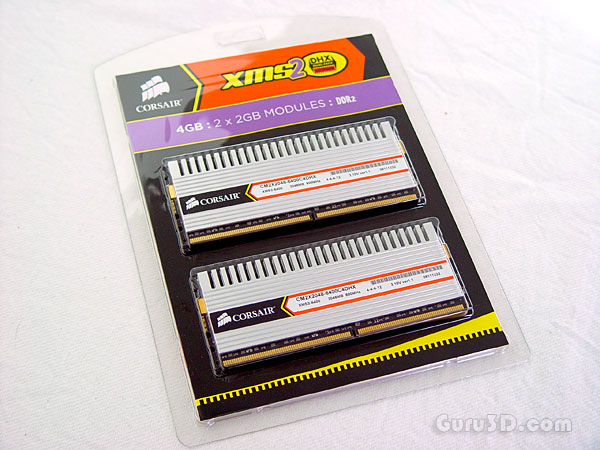4 - 32-bit memory hole & Corsair DHX Memory
What's with all those Gigabytes of memory?
Windows 98, who didn't use that OS? What amount of memory did your PC have? Right, likely 128 MB.
Over the years we progressed and noticed that applications have gotten more and more memory intensive. With Windows XP we moved towards 512 MB as standard to prevent the OS from swapping to the HD, and as explained on the previous page with the latest games we see that the certain games really like 1 GB. All this has happened over just a couple of years my friends. Then Microsoft launched Windows Vista, the biggest memory hog in the world. 1 GB is just be the average recommended specification. They actually recommend 2 GB. See... 2GB isn't that special anymore.
But with memory prices coming down you might even consider taking it a step further, this 4GB kit is FAST and CHEAP. Why not ?
Running into a Windows 32-bit brick wall ...
A fair question we hear a lot is can I use 4 GB of memory on a 32-bit platform ?? Yes and no.
As far as 32-bit Vista is concerned, the world ends at 4,096 megabytes. While 4 GB will run just fine, with for example Windows Vista 32-bit your memory size will be limited and you'll only have 2.8 to 3.2 GB out of the 4 GB available to you.
This isn't a Windows problem-- it's an x86 limitation. To address 4GB of memory you need 32 bits of address bus. There however is a problem - actually a similar problem that IBM faced when designing the original PC. You tend to want to have more than just memory in a computer - you need things like graphics cards and hard disks to be accessible to the computer in order for it to be able to use them.
Microsoft call this MMIO (Memory-Mapped I/O).
For example, if you have a video card that has 256 MB of onboard memory, that memory must be mapped within the first 4 GB of address space. If 4 GB of system memory is already installed, part of that address space must be reserved by the graphics memory mapping. Graphics memory mapping overwrites a part of the system memory. These conditions reduce the total amount of system memory that is available to the operating system.
So just as the original PC had to carve up the 8086's 1MB addressing range into memory (640K) and 'other' (384K), the same problem exists today if you want to fit memory and devices into a 32-bit address range: not all of the available 4GB of address space can be given over to memory. For a long time this wasn't a problem, because there was a whole 4GB of address space, so devices typically lurk up in the top 1GB of physical address space, leaving the bottom 3GB for memory. And 3GB should be enough for anyone, right?
So what actually happens if you go out and buy 4GB of memory for your PC? Well, it's just like the DOS days - there's a hole in your memory map for the IO. (Now it's only 25% of the total address space, but it's still a big hole.) So the bottom 3GB of your memory will be available, but there's a discrepancy with that last GB.
If you want it all, go with a 64-bit OS. In 64-bit Windows, the limit is gone. But on 32-bit some of the available memory size will evaporate. But you'll still have near 3 GB of memory available.
Corsair TWIN2X4096-6400C4DHX memory
As you probably found out by now, today we'll test a 88 EUR costing 4 GB kit, with quite honestly really spiffy timings. Now even if the memory would perform lower than regular DDR2 800 MHz memory, it'd still be a bargain. But as our tests will show you, thanks to it's low-latency 800MHz kit (4-4-4-12) timings it's ranking up there with very high-performance.
Corsair XMS2 DHX series of memory is targeted to be a mainstream product, their Dominator series is the high-end enthusiast product line.
The DHX series needs a little explaining though. DHX actually refers to the memory heatsink / heatspreader slapped on top of that DIMM. Though a little medieval looking, it actually cools both the front of the memory ICs and also the heat escaping from the BGA leads connecting the ICs to the PCB.
DHX modules have an extended PCB/grounding plane (which we'll show you in the photo shoot) and Corsair connects their heatsink to the grounding plane too, giving a metal-to-metal heat path. Now according to Corsair; no-one else does this (because it is patented by Corsair) every other memory cooler, no matter how elaborate, is just stuck to the face of the ICs. Corsair also does this yet uses a second heat dissipation path on the PCB. Clever actually.
We already discussed it a little on our EPP /SLI-Ready memory part, yet once you pop in the memory (and do not have an nForce mainboard with SLI Ready memory enabled) your system will configure the memory at JEDEC timings.
If that applies to you, remember, this memory can go faster. Go load up the BIOS, crank up memory voltage towards 2.1 Volts and set that memory at 4-4-4-12 timings.
Some facts on the TWIN2X4096-6400C4DHX kit:
-
Low latency timings @ 4-4-4-12
-
Two matched 2GB modules (for dual-channel)
-
DHX heatspreader / technology
-
Modules are hand-tested
-
Life Time Warranty
Yes correct, it comes even with a life-time warranty. Now that's a very beefy memory kit at roughly 88 EUR.
First let's have a good look at the modules tested today, the 4 GB kit from Corsair under SKU name TWIN2X4096-6400C4DHX.

The clear blister packaging lets you get a good view of the modules and visible are the DHX heatspreaders.
